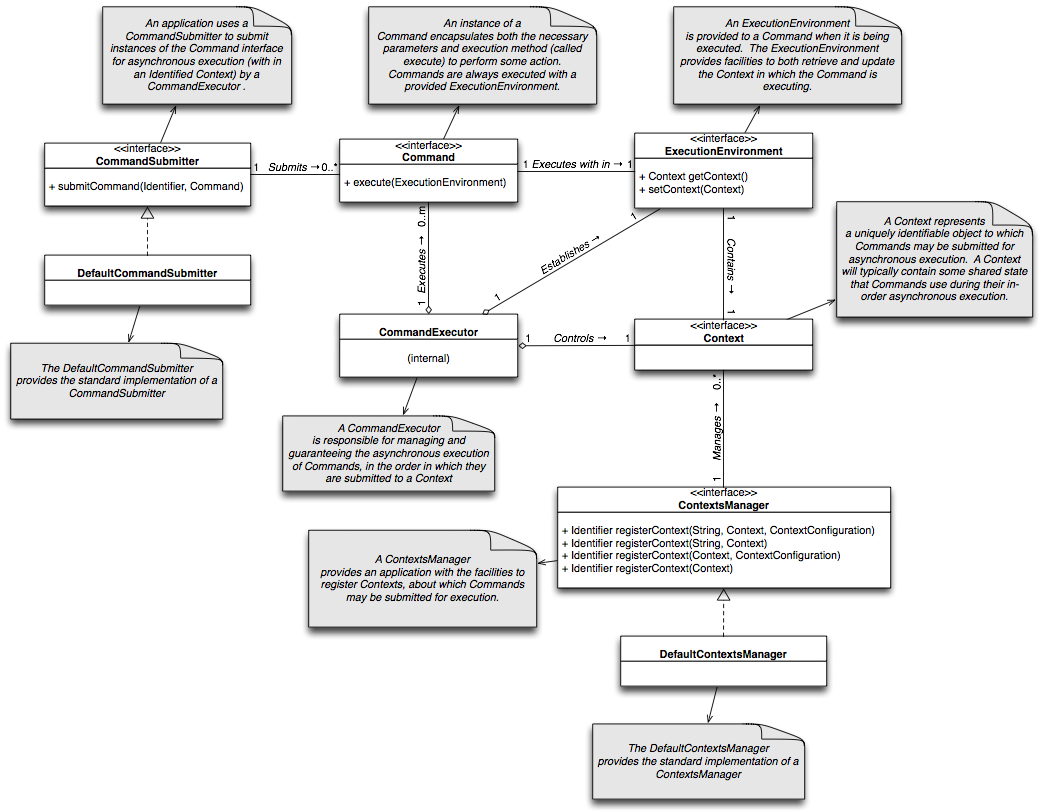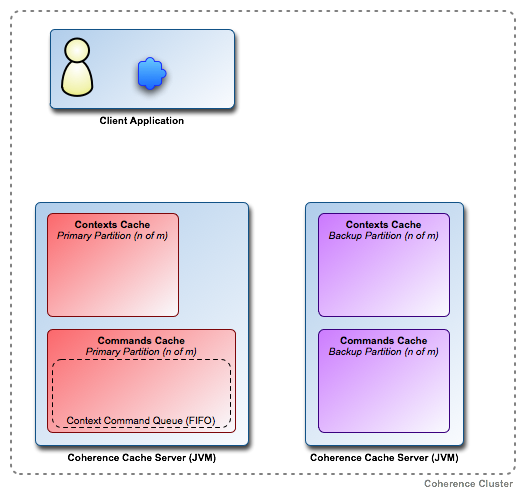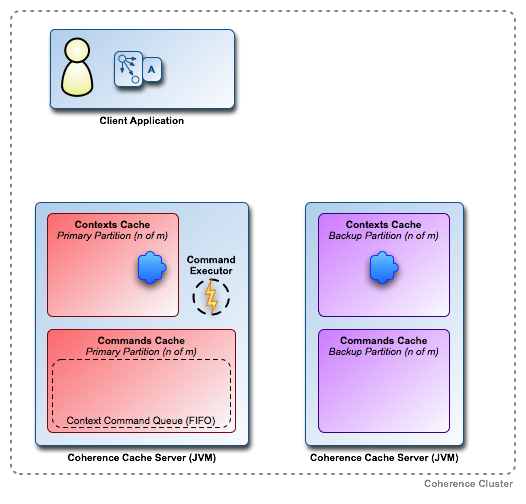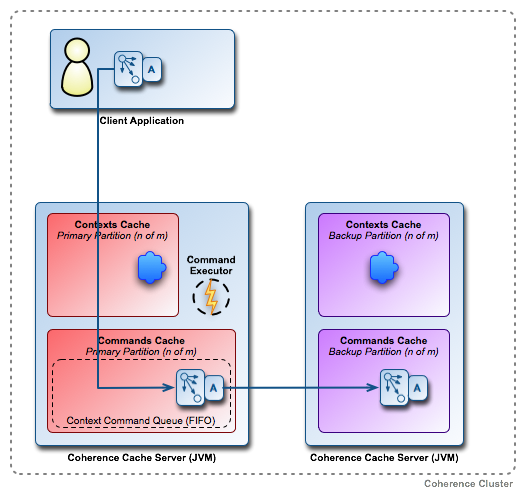The Command Pattern
Overview
Provides a distributed implementation of the classic Command Pattern (Wikipedia) built using Oracle Coherence.
Distribution
The Command Pattern implementation is distributed in the jar file
called: coherence-commandpattern-11.0.0.jar.
However as the Command Pattern has several other dependencies, we **strongly recommend** that developers adopt and use tools like Apache Maven/Ivy/Gradle to transitively resolve the said dependencies, instead of attempting to do so manually.
To configure your Apache Maven-based application to use the Command Pattern,
simply add the following declaration to your application pom.xml file
<dependencies> element.
<dependency>
<groupId>com.oracle.coherence.incubator</groupId>
<artifactId>coherence-commandpattern</artifactId>
<version>11.0.0</version>
</dependency>
Details
The Command Pattern advocates that:
* An action to be performed zero or more times at some point in the future
should be represented as an object called a Command.
All necessary parameters required to perform the said action, should be encapsulated as attributes with in the said
Command.The
Commandmust provide a mechanism to perform the action, typically represented by anexecutemethod defined on the saidCommand.
This implementation of the Command Pattern additionally advocates that:
* A Command may only be executed with in the scope of a target object,
called a Context
To execute a
Commandit must be submitted to aContextOnce submitted,
Commandsare executed asynchronously. That is, the submitter of theCommanddoes not block or wait for theCommandto be executed after it has been submitted.Commandsare executed one-at-a-time, in the order in which they arrive at theirContextA
Commandmay not return a value to the application that submitted the saidCommand. If you require aCommandthat returns a value after execution, you need aFunctor(see the Functor Pattern.)
Design
The following diagram outlines the core classes and interfaces defined in this implementation of the Command Pattern.

The Command interface specifies the minimum requirements for Commands. It
defines a single method called execute that is invoked by the internal
CommandExecutor when a Command is to be executed. The execute method
requires a single parameter, called the ExecutionEnvironment. The
ExecutionEnvironment provides valuable information to the execute method,
including the Context in which the Command is being executed. To submit
Commands for execution by CommandExecutors, you must use an implementation
of the CommandSubmitter interface (the DefaultCommandSubmitter class
provides the standard implementation).
To define and register a Context about which you may submit Commands for
execution, use an implementation of the ContextsManager interface (the
DefaultContextsManager class provides the standard implementation). Once a
Context is registered, you may use the returned Identifier to submit Commands
for execution with a CommandSubmitter.
As
ContextandCommandinstances are stored in Coherence cluster members, they both must beSerializableor better still, implementExternalizableLiteorPortableObject.
Command Pattern Usage Walkthrough
Step 1: The Initial Environment

- One Client Application
- Two Coherence Cache Servers
- All part of the same Coherence Cluster
The Client Application may be external to the Coherence Cluster when using Coherence Extend
Step 2: Context Creation

- The client application creates an instance of a
Context
Step 3: Context Registration

The client application registers the created
Contextusing aContextsManagerThe
ContextsManagerplaces theContextinto a "primary partition" of the "contexts" Distributed Cache.Coherence ensures a backup of the
Contextis made to a "backup partition" (on separate JVMs and different machines where possible)
Step 4: Establishing the CommandExecutor (automatic)

- When a
Contextis registered, an internal event establishes an appropriateCommandExecutorand necessary infrastructure.
Step 5: Creating a Command

- The client application creates an instance of a
Command
Step 6: Submitting a Command for execution

The client application uses a
CommandSubmitterto submit aCommandfor execution with an identifiedContextThe submitted
Commandis placed into the "commands" Distributed Cache (and automatically backed up)The submitted
Commandis then automatically queued (FIFO) and scheduled for asynchronous execution by theCommandExecutorfor theContext
An individual
Commandinstance may be submitted any number of times for execution to one or moreContexts. There is no need to create new instances of the sameCommandif it needs to be submitted for execution multiple times.
Step 7: Numerous Command Submission

- Multiple
Commandsmay be submitted for execution at once. Commandsare queued for execution (FIFO) in order of arrival at theContext
Step 8: Commands are executed by the CommandExecutor (Asynchronously)

When
Commandsare queued for execution, an internal event notifies theCommandExecutorto start executing theCommandsFor efficiency, the
CommandExecutormay executeCommandsin batches (but remaining in order).
Step 9: Commands Automatically Cleaned-up when Executed.

- Once a
Commandhas been executed, it is removed from the "commands" cache (as is the backup of theCommand).
Example
Let's start with a simple example where we use the Command Pattern to setValue(T)
on the GenericContext.
First, we'll start by writing a simple SetValueCommand that extends `
AbstractCommand` as seen here:
import java.io.DataInput;
import java.io.DataOutput;
import java.io.IOException;
import com.oracle.coherence.patterns.command.Command;
import com.oracle.coherence.patterns.command.ExecutionEnvironment;
import com.tangosol.io.ExternalizableLite;
import com.tangosol.util.ExternalizableHelper;
@SuppressWarnings("serial")
public class SetValueCommand<T> implements Command<GenericContext<T>>, ExternalizableLite {
private T value;
public SetValueCommand() {
}
public SetValueCommand(T value) {
this.value = value;
}
public void execute(ExecutionEnvironment<GenericContext<T>> executionEnvironment) {
GenericContext<T> context = executionEnvironment.getContext();
context.setValue(value);
executionEnvironment.setContext(context);
}
@SuppressWarnings("unchecked")
public void readExternal(DataInput in) throws IOException {
this.value = (T)ExternalizableHelper.readObject(in);
}
public void writeExternal(DataOutput out) throws IOException {
ExternalizableHelper.writeObject(out, value);
}
public String toString() {
return String.format("SetValueCommand{value=%s}", value);
}
}
Second, let's write a quick test that submits a number (iCount) of
SetValueCommand s on "mycontext" as seen here:
import com.oracle.coherence.common.identifiers.Identifier;
import com.oracle.coherence.patterns.command.CommandSubmitter;
import com.oracle.coherence.patterns.command.ContextsManager;
import com.oracle.coherence.patterns.command.DefaultCommandSubmitter;
import com.oracle.coherence.patterns.command.DefaultContextConfiguration;
import com.oracle.coherence.patterns.command.DefaultContextsManager;
import com.oracle.coherence.patterns.command.ContextConfiguration.ManagementStrategy;
import com.tangosol.net.CacheFactory;
public class CommandPatternExample {
/**
* @param args
* @throws InterruptedException
*/
public static void main(String[] args) throws InterruptedException {
DefaultContextConfiguration contextConfiguration = new DefaultContextConfiguration(ManagementStrategy.DISTRIBUTED);
ContextsManager contextsManager = DefaultContextsManager.getInstance();
Identifier contextIdentifier = contextsManager.registerContext("mycontext", new GenericContext<Long>(0L), contextConfiguration);
CommandSubmitter commandSubmitter = DefaultCommandSubmitter.getInstance();
commandSubmitter.submitCommand(contextIdentifier, new LoggingCommand("Commenced", 0));
for (long i = 1; i <= 10000; i++) {
commandSubmitter.submitCommand(contextIdentifier, new SetValueCommand<Long>(i));
}
commandSubmitter.submitCommand(contextIdentifier, new LoggingCommand("Completed", 0));
CacheFactory.shutdown();
}
}
To run this test you will need to start a Coherence cache server, in this example
we use the DefaultCacheServer that ships with Coherence as seen here:
java -Dtangosol.coherence.cacheconfig=$PATH_TO/coherence-commandpattern-cacheconfig.xml \
com.tangosol.net.DefaultCacheServer
Once the cache server is running you can start the CommandPatternExample as a
cache client as seen here:
java -Dtangosol.coherence.distributed.localstorage=false -Dtangosol.coherence.cacheconfig=$PATH_TO/coherence-commandpattern-cacheconfig.xml CommandPatternExample
The SetValueCommand.java, CommandPatternExample.java and coherence-commandpattern-cache-config.xml
files are included in the source code distribution.
Frequently Asked Questions
What is the relationship between the Functor Pattern, Command Pattern, Entry Processors and the Invocation Service for performing work in a cluster?
The following table outlines the main differences.
| Description | Functor Pattern | Command Pattern | EntryProcessors | InvocationService |
| Processing Target | A Context | A Context | A Cache Entry | A Cluster Member |
| Submission Behavior | Non-Blocking | Non-Blocking | Blocking | Blocking and Non-Blocking |
| Execution Order | Order of Submission | Order of Submission | Order of Submission^1 | Order of Submission |
| Supports Return Values? | Yes | No | Yes | Yes |
| Guaranteed to Execute?^2 | Yes | Yes | Yes^3 | Yes^4 and No^5 |
| Guaranteed to Execute?^6 | Yes | Yes | Yes^7 | No^8 |
| Recoverable?^9 | Yes^10 | Yes^10 | No | No |
| Request may be cancelled? | Yes | Yes | No | Yes ^5 |
- Unless using PriorityTasks
- If Submitter terminates after submission
- Submitter blocks
- For blocking calls
- For non-blocking calls
- If Target JVM terminates during execution
- Submitter automatically retries
- Retry up the responsibility of the developer
- Recoverable from disk
- When using a Cache Store
What is a ManagementStrategy?
A ManagementStrategy defines how Commands are managed in a Coherence Cluster.
By default Commands are always co-located in the JVM that is hosting the Context
associated with the said Commands. This provides instant access to the Commands
for a CommandExecutor but has the disadvantage of limiting the number of Commands
that may be queued for execution (before a JVM may run out of memory). The alternative
is to use the DISTRIBUTED strategy, where the Commands are distributed across
the cluster and only retrieved for execution when required. This provides the
advantage of enabling massive capacity (scaling to the size of the cluster and
beyond when disk storage is configured), but has the disadvantage that retrieving
Commands for execution may take longer.
How do I monitor the execution of Commands?
The Command Pattern CommandExecutors are JMX enabled by default. In order
to monitor Command execution for a Context, simply enable JMX for Coherence
and look for the "CommandExecutors" in your JMX monitoring application
(ie: Something like JConsole). All kinds of JMX information is available,
including Min, Max and Average Execution time, together with the number of
current Commands pending to be executed and those that have been executed.
References and Additional Information
Wikipedia - Command Pattern

